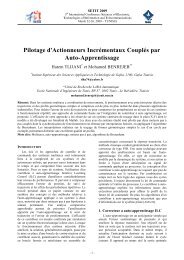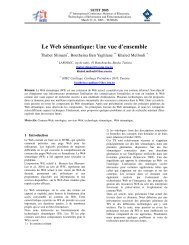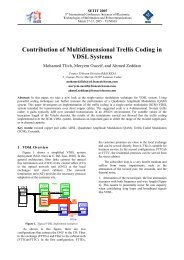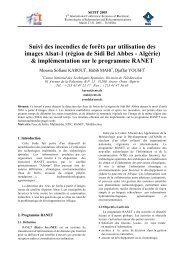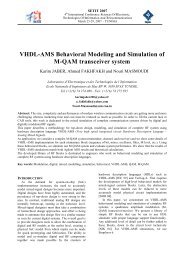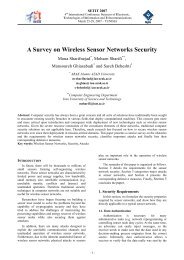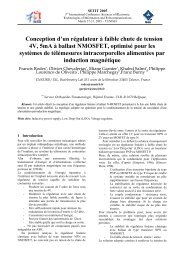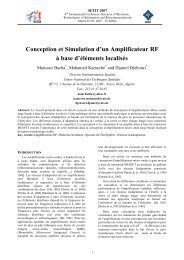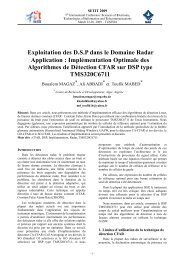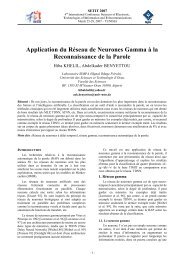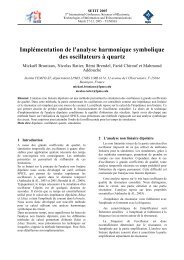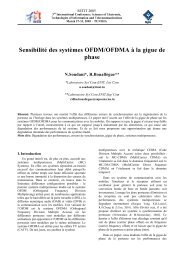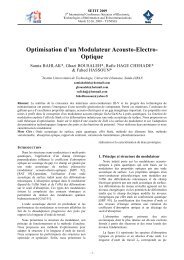Mobility Issues in Hierarchical Mobile IP
Mobility Issues in Hierarchical Mobile IP
Mobility Issues in Hierarchical Mobile IP
Create successful ePaper yourself
Turn your PDF publications into a flip-book with our unique Google optimized e-Paper software.
SETIT2005<br />
AVERAGE END2END DELAY<br />
ave. end2end delay (ms)<br />
16.000<br />
14.000<br />
12.000<br />
10.000<br />
8.000<br />
6.000<br />
4.000<br />
2.000<br />
0.000<br />
M<strong>IP</strong> delay<br />
HM<strong>IP</strong> delay<br />
0 100 200 300 400 500 600 700 800 900 1000<br />
packet size (bytes)<br />
Figure 5 (a). Signal<strong>in</strong>g Load <strong>in</strong> M<strong>IP</strong><br />
Figure 4. Comparison of End2End Delay<br />
From the graph, for M<strong>IP</strong> the delay starts at 4ms and<br />
it <strong>in</strong>creases and decreases <strong>in</strong>consistently. The delay is<br />
caused by the congestion of traffic and the queue size<br />
limitation that is set. The packets will be buffered<br />
before be<strong>in</strong>g forwarded. The delay <strong>in</strong>creases and<br />
decreases <strong>in</strong>consistently because of the registration to<br />
the HA through the Internet frequently.<br />
A<br />
conclusion can also be made that as the number of<br />
packets <strong>in</strong>crease, so will the delay. It can also be<br />
concluded that packets size and delay are relatively<br />
proportional <strong>in</strong> M<strong>IP</strong>.<br />
In HM<strong>IP</strong>¸ the delay starts at 6ms because of the<br />
l<strong>in</strong>ks delay (propagation delay) <strong>in</strong> the topology. At 100<br />
bytes the delay starts to <strong>in</strong>crease, this is because, at<br />
this time the MN will have to register to it’s HA and it<br />
has to wait for the registration reply from the HA<br />
(<strong>in</strong>ter-doma<strong>in</strong> communication). When HA knows the<br />
CoA of MN (equals to the GFA CoA), only then the<br />
MN can starts to receive and send packets. In HM<strong>IP</strong><br />
there is slight <strong>in</strong>crement and decrement <strong>in</strong> delay. This<br />
happens because of the registration process to the GFA<br />
as the MN changes its po<strong>in</strong>t of attachment with<strong>in</strong> the<br />
doma<strong>in</strong> (<strong>in</strong>tra-doma<strong>in</strong> communication).<br />
Figure 5 (b). Signal<strong>in</strong>g Load <strong>in</strong> M<strong>IP</strong> after MN<br />
changes its Po<strong>in</strong>t-of-Attachment<br />
For HM<strong>IP</strong>, when the MN moves to a foreign<br />
network for the first time, it will have to send a<br />
registration request to the HA. Then it will have to<br />
wait for a registration reply from the HA. Here, the<br />
CoA of the MN will be the same as its GFA. This is<br />
illustrated <strong>in</strong> Figure 6 (a)<br />
3.3 Signal<strong>in</strong>g Load<br />
In M<strong>IP</strong>, when a MN moves to a foreign network, it<br />
will have to go through a registration process. At first,<br />
it will send a registration request to HA. Then the HA<br />
will send the registration reply to the MN. As shown<br />
<strong>in</strong> Figure 5 (a).<br />
This means that the HA knows the CoA of the MN.<br />
The discrepancy here is that every registration process<br />
will have to go through the Internet (because M<strong>IP</strong> is<br />
macromobility). This will result <strong>in</strong> signal<strong>in</strong>g overhead<br />
at the Internet and it will cause delay, packet loss and<br />
also handoff latency dur<strong>in</strong>g transmission. The next<br />
time MN changes its po<strong>in</strong>t of attachment, the same<br />
process will be repeated as shown <strong>in</strong> Figure 5 (b).<br />
Figure 6 (a). Signal<strong>in</strong>g Load <strong>in</strong> HM<strong>IP</strong> (first<br />
registration to the HA and GFA)




